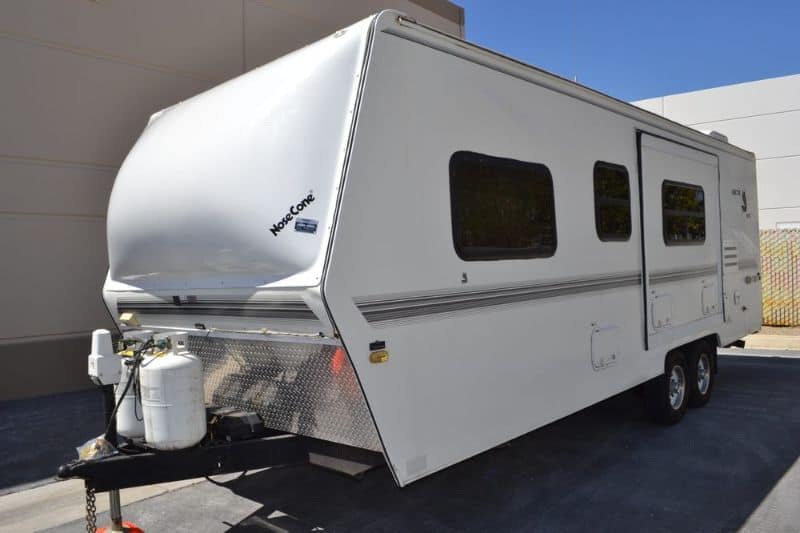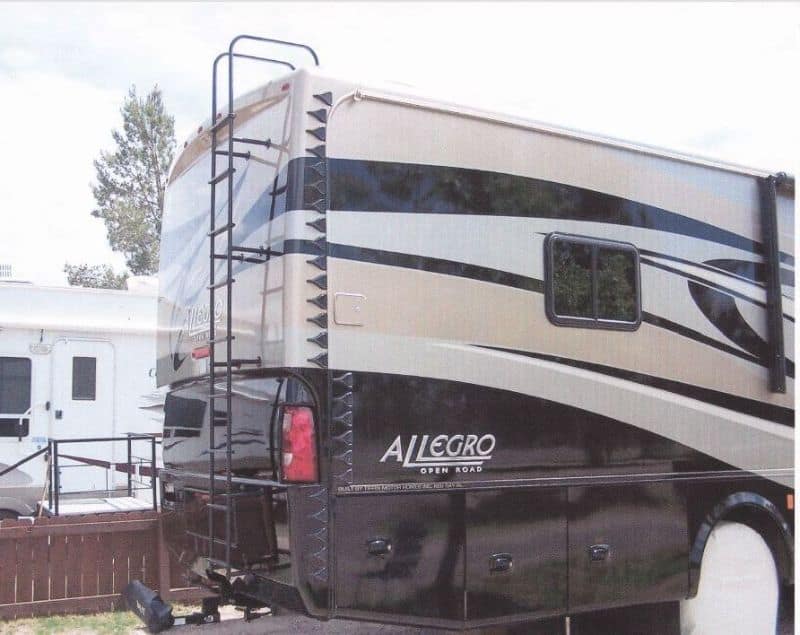Gas mileage is a source of shame for most RV owners. In this modern day of stainless steel straws and rice utensils and urban green roofs, RVs chug gas like it’s alcohol at a frat party.
Blame the aerodynamics (or lack thereof). Most RVs have lots of curb appeal but the aerodynamics of a 2×4. When we drive, we’re not just fighting gravity. We’re dragging an RV through a fluid that swirls, flows, and exerts pressure. Air may not be as thick as water, but at 65 mph, it’s plenty powerful!
It’s best for you (and your wallet) to drive an RV with the best fuel efficiency possible. So let’s talk about RV aerodynamics. And perhaps it’s best to begin with the Serenity Prayer:
“God, grant me the serenity to accept the things I cannot change …”
(And, by the way, I apologize. At the end of this post, I’m going to burst your bubble anyway.)
RVs Are Incredibly Un-Aerodynamic
As a kid, you probably stuck your hand out the car window and pretended your hand was a dolphin. But if your hand flattened out – wham! – the wind would almost rip your hand off!
RVs work the same way. Because you’re basically driving a parachute with an engine.
Most RV manufacturers generally DO NOT use wind-tunnel testing to evaluate the aerodynamics of their RV designs. Curb appeal and layout drive the shape, not aerodynamics.
But don’t blame the manufacturers too much.
For one thing, RVs are designed to be living quarters. And do you know what humans like? Boxes. Rectangles. Square cabinets, rectangular beds, cube refrigerators, etc. Curvy rooflines aren’t good for headroom.
Plus, why go through the tremendous work of designing a fish-like body when you’re going to add on a box-shaped air conditioner, box-shaped roof fans, a box-shaped awning, roof pipes, a ladder, and a bunch of handles and latches?
All those roof penetrations and door handles and appliance vents really ruin the “slipperiness.” So does the underbelly with all the low-point drains, spare tires, sewer valve, and other penetrations.
Almost no RVs are designed to be aerodynamic. Even the ones that try hard, like the Snoozy 2 travel trailer, still have major concessions: side-mounted fenders, open frames, and wall-mounted spare tires.

(I do like the Snoozy. I just wouldn’t say they’ve cracked the code for groundbreaking RV aerodynamics.)
How Do You Pick (or Modify) an RV for Better Aerodynamics and Fuel Efficiency?
Let’s look at the main factors that influence aerodynamics and fuel efficiency:
- Minimizing the frontal area
- Tapering the back wall
- Installing a wind deflector
- Covering up exterior protrusions
Minimize the Frontal Area
As a (very) rough rule of thumb, the bigger your RV, the worse the gas mileage. But think of this way: Any height beneath your tow vehicle (if you’re towing) is hidden! It’s sheltered!
(This isn’t completely true, since there are many other factors at play, but it’s a mostly-true concept).
A good place to start is by multiplying the width of your RV by the height. That’s called frontal area. The bigger the frontal area, the bigger the parachute, the worse the fuel efficiency – especially if your RV is taller than your tow vehicle!
The shape of the frontal area matters a lot, too. Having a curved front (especially towards the top) can significantly streamline airflow. Even better is a Nose Cone, like this:

Most modern 5th wheels have molded fiberglass front caps which can significantly improve efficiency by 1-3 mpg! They sort of double as nose cones, too.
Hint: You can also reduce the effective frontal area by reducing your RV ground clearance, either through smaller tires, using drop axles, etc. Generally, though, this is not recommended. Most RVs need all the ground clearance they can get!
P.S. Personally, I’m not a huge fan of V noses, common on luxury cargo trailers. They do slightly improve fuel efficiency but at a huge detriment to living space. Not worth it, in my opinion.
Solutions
Unfortunately, your options for minimizing the frontal area are limited and come with major trade-offs.
- For towables: You can get a diminutive Scamp or Casita travel trailer – but you’ll have almost no room!
- For motorhomes: Look for the shortest option. If you’re willing to forego the second floor bed, you might consider a Class B+ rather than a Class C, for instance.
- Get a nose cone. This is most helpful for older travel trailers with flat, sloped front walls.
- Avoid wide-body RVs. These offer much more lounge space (up to 102” wide), but they are difficult to pilot on backroads (or illegal) and less fuel-efficient.
Check Out That Booty
Most people intuitively understand that the taller and wider an RV, the more drag it creates. But guess what?
The flat rear on most RVs tries to suck the RV back where it came from. And actually, it’s that flat rear that really kills fuel efficiency!
When an RV passes through air, it splits the fluid. As it passes the same point, air rushes behind the RV trying to fill the void, which creates major turbulence and vacuum pressure.
Solutions
You might be lucky enough to have an RV with a curvy rear end.

- Airstreams and Bowlers are naturally somewhat aerodynamic with their “silver bullet” profile.
- Teardrop campers boast superior fuel efficiency thanks to their tapered rooflines.
- Americana 5th wheels (a smaller brand) makes tapered fiberglass rear caps to minimize air drag.
If your RV is shaped like the typical travel trailer or 5th wheel, though, you need to get creative. You might be able to create your own rear wall wind deflectors using ABS plastic sheet and a heat gun.
A more practical solution is to use AirTabs. These nifty devices can improve fuel efficiency by 2-5 percent AND, what’s even better, improve highway handling at the same time!

Install a Wind Deflector
Wind deflectors are the subject of much raging debate. Some say they work; some say they’re a scam.
These devices are pretty simple. They act like air ramps, directing wind up and over your towable RV rather than smashing into the front.
You can get RV wind deflectors for your truck or van while towing a 5th wheel or travel trailer.
Unfortunately, the devil is in the details.
- Mount the deflector too far away from the trailer’s front cap, and it will do no good.
- Choose a deflector that is too narrow (looking at you, wide-body RVs!) and it will do no good.
- Mount the deflector at too steep an angle, and it will turn into a sail.
- Towing an RV that already has a molded front cap with rounded corners? You’ll probably see no measurable benefit.
In fact, some studies show that the best place to install a wind deflector is on the RV itself! The angled plastic will deflect wind around all your roof components, which create most of the drag anyway.
Here’s one of the more popular RV wind deflectors from Icon Direct.

And for your reading pleasure, I found a newspaper article from 1996 about a guy who developed his own travel trailer nose cone deflector!
Cover Up the Air Dams
Did you know automotive designers hate passenger mirrors and windshield wipers?
‘Tis true. Those pesky safety devices absolutely wreck the aerodynamics of otherwise super-slippery vehicles.
Similarly, the big protrusions out of your RV – the air conditioner, roof fans, underbelly tanks, etc. – really kill its fuel efficiency. Here are the worst culprits:
- Air conditioner
- Roof fans
- Underbelly tanks
- Awnings
- Ladders
You can buy aftermarket shrouds for most roof-mounted items, such as your air conditioners. You can also replace your stock A/C with a low-profile version, like the Dometic Penguin II.
Open underbellies can be particularly problematic. If you have an RV (usually a travel trailer) with an exposed frame, tanks, piping, etc, you’re looking at an aerodynamic nightmare.
If you can, cover it up with coroplast or another underbelly material. If you can’t, repeat the Serenity prayer, and enjoy the weekend.

Conclusion
I warned you I was going to burst your bubble. So don’t shoot the messenger.
The truth is I don’t know anyone who has significantly improved their fuel economy by “modding” their RV.
“Significantly” isn’t a number, of course. To some people, a 10% improvement is significant. And yes, you could probably improve your fuel efficiency by 10% by using wind deflectors, covering the underbelly, installing roof shrouds, etc.
You’re still driving a brick with handles, lights, vents, doors, antennas, and caps poking out of it like so many pins and needles.
I’m not trying to dissuade you! If you drive 15,000 miles a year in your Class A motorhome which gets 7 mph, then a bump to 8 or even 9 mpg would be incredible!
But you know what can instantly improve your fuel efficiency for FREE, starting right now, and never wears out?
Driving at 55 mph!
There comes a point when you’re stepping over dollars to pick up pennies. Sure, you could enclose the wheels, get rid of your towing mirrors, – but stomping on the gas pedal to pass up on “idiot on the highway” would kill your fuel savings for a week.
When you drive a motorhome, you’re exchanging a mortgage payment for a credit card at the fuel pump. That’s the bargain you made.
If you’re still determined to own a super aerodynamic RV, may I recommend this 1982 Vixen motorhome?
Leave a Reply